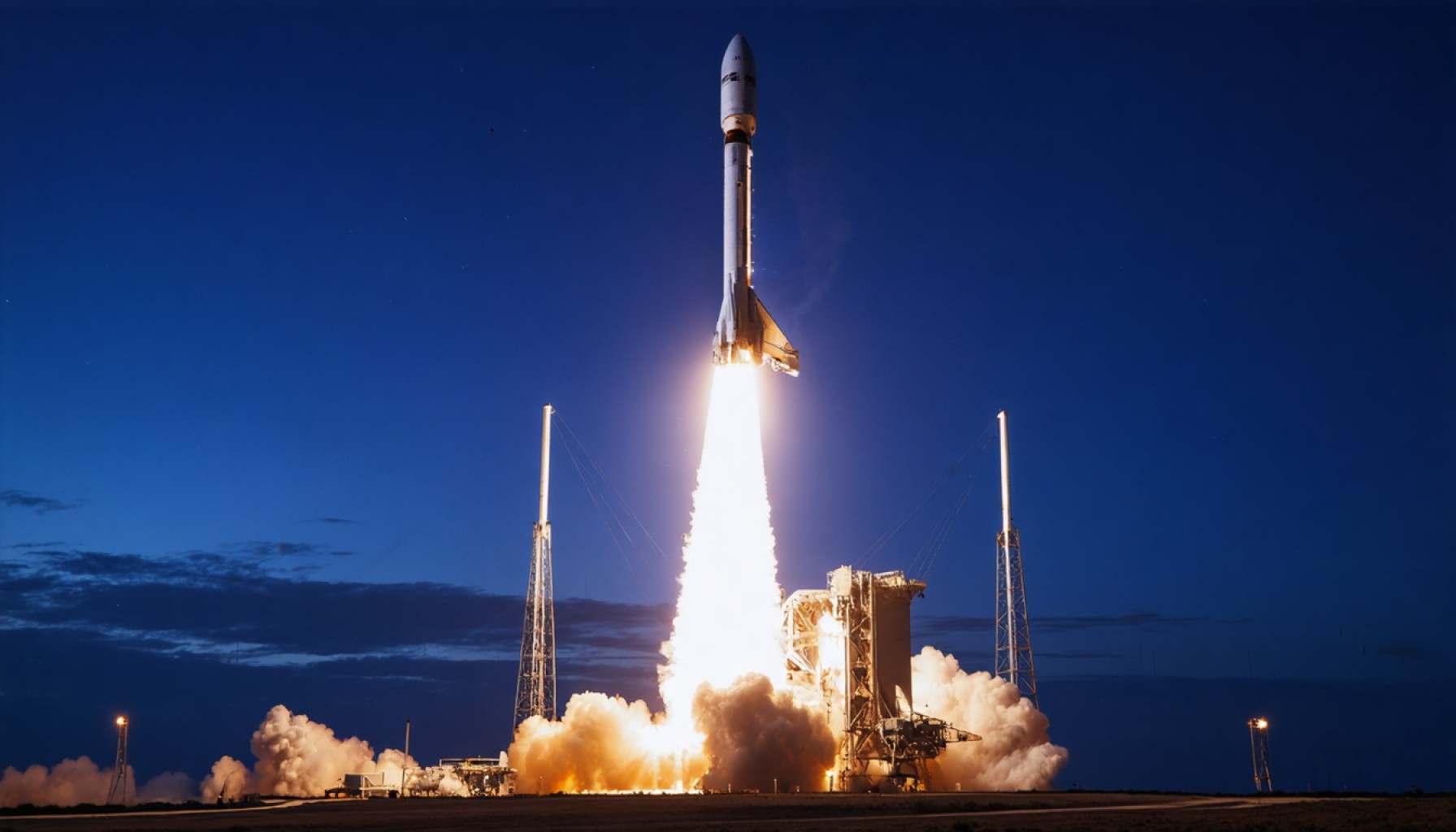- The Falcon 9 rocket is launching at 9:59 p.m. EDT from Cape Canaveral, carrying 27 Starlink satellites to enhance global internet connectivity.
- The launch marks the 27th mission for the robust first-stage booster, which has supported various missions, including deliveries to the ISS and international satellite deployments.
- The mission involves a planned first-stage landing on a drone ship in the Atlantic Ocean eight minutes after liftoff.
- No sonic boom is expected; the Falcon 9 will follow a southeasterly trajectory into the night sky.
- This launch contributes to the expanding Starlink network, aiming to provide high-speed internet to remote areas and bridge the digital divide.
- The mission highlights human ingenuity and ambition for global connectivity.
As darkness drapes over Florida’s Space Coast, another marvel of technology readies to pierce the night. The Falcon 9 rocket, a testament to engineering prowess, stands poised at Launch Complex 40, eagerly awaiting its moment to ascend into the cosmos. When the clock strikes 9:59 p.m. EDT, the engines may rumble to life, sending 27 Starlink satellites on a celestial journey to expand global internet connectivity.
The night will mark a milestone for the seasoned first-stage booster, embarking on its 27th mission—a journey that crisscrosses the history of modern space travel. This robust booster has supported critical missions, from delivering crucial supplies to the International Space Station to launching ambitious international satellites. Like an old, trusted vessel, it will once again aim to land on the ever-patient drone ship, gently bobbing on the Atlantic, eight minutes post-liftoff.
Spectators along the coast might prepare for the spectacle, yet no sonic booms will break the night. The Falcon 9 will pursue a serene southeasterly track, slipping into the night sky with a whisper. Each mission adds a ripple to the ever-evolving fabric of human ingenuity and exploration.
Tonight’s endeavor is not just about the technological dance of metal and fire; it’s a chapter in the larger narrative of connecting the world. The Starlink constellation, a sprawling network of satellites, continues to grow, aiming to deliver high-speed internet to the most remote corners of our planet. It’s a bold step towards bridging the digital divide, making the night’s work not just a feat of engineering, but a testament to global ambition.
The takeaway? Every launch, each satellite gently released into orbit, is a leap towards a more connected future. In the quiet of the night, as observers cast their eyes skyward, the faint glow of technology’s advancement arcs silently over a sleeping world, promising progress and connectivity for all.
How the Falcon 9’s Night Launches Redefine Global Connectivity and Innovation
The Falcon 9 rocket has become emblematic of both engineering excellence and the relentless pursuit to connect the world. Its latest mission from Florida’s Space Coast signifies more than just another night launch; it represents a pivotal moment in the journey towards a globally connected future.
Key Technological Achievements
1. Reusable Booster Technology: The specific Falcon 9 booster used for this launch is notable for its reliability and reusability, marking its 27th mission. This reusability reduces costs and sets a precedent for sustainable space travel.
2. Starlink’s Global Impact: With each launch, the Starlink constellation creeps closer to its goal of providing worldwide internet coverage. Remote areas that lack reliable internet stand to benefit the most, transforming lives by opening up opportunities for education, healthcare, and economic development.
3. Precision Landings: Falcon 9’s ability to land on a drone ship post-launch showcases remarkable precision engineering. These landings demonstrate advancements in guidance systems and rocket recovery capabilities.
Life Hacks and How-To Steps
– Witnessing a Launch: To safely view a Falcon 9 launch, consider accessing a live stream from SpaceX’s website. Watching from a recommended public site such as Jetty Park in Cape Canaveral while adhering to any local guidelines can enhance the experience.
– Starlink Connection: For individuals in remote areas, setting up Starlink involves registering on the official website, receiving the necessary equipment, and positioning the dish for optimal sky visibility. Follow user manuals for assembly and troubleshooting.
Real-World Use Cases
– Education Accessibility: Starlink can bridge educational gaps by providing students in remote locations high-speed internet for remote learning.
– Telemedicine: Remote communities can access critical telemedicine services with reliable internet provided by Starlink, offering life-saving consultations and healthcare guidance.
Industry Trends and Market Forecasts
The demand for low-latency, high-speed internet is expected to grow exponentially. According to a report by MarketsandMarkets, the global satellite internet market is projected to reach $18.8 billion by 2025. Companies like SpaceX and Amazon’s Project Kuiper will intensify competition, driving innovation and potentially lowering costs.
Pros and Cons Overview
Pros:
– Improved global internet access, especially in underserved regions.
– Advancement in sustainable space travel through reusability.
– Precise and efficient satellite deployments.
Cons:
– Potential for increased space debris due to the growing number of satellites.
– Concerns relating to astronomy, as satellites may affect night sky observations.
Controversies and Limitations
– Space Debris: As the number of satellites increases, so do concerns over space debris, which can pose risks to other satellites and space missions.
– Regulatory Hurdles: Navigating international regulations concerning satellite operations can be complex, requiring negotiations with multiple national and international bodies.
Security and Sustainability
Security measures for Starlink ensure encrypted communications. However, like with any tech infrastructure, continuous updates and monitoring are essential for maintaining security integrity. The focus on reusability aligns with sustainability goals, minimizing waste and reducing environmental impact.
Actionable Recommendations
– Individuals interested in satellite internet options should monitor Starlink’s coverage map and follow updates for service availability in their region.
– Aspiring engineers and tech enthusiasts should consider the transformative potential of participating in space technology sectors that emphasize sustainability and connectivity.
As the night sky hosts another Falcon 9 endeavor, the world edges closer to a future where universal internet connectivity signals not just technological progress, but equitable access to the digital world. For more information, explore SpaceX and Starlink.
